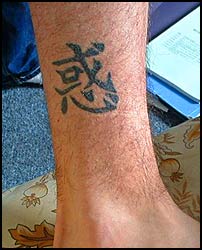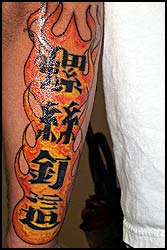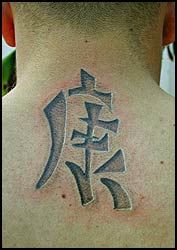Tian that runs the always funny “kanji debunking” blog Hanzi Smatter has been keeping me updated as to the many errors that show up in BME’s kanji tattoo gallery. Here are a few recent errors:
 Thought it meant: Chaos slogan Actually means: Nothing, due to missing dot. (Tian speculates that artists are sharing bad flash) |

Thought it meant: “I can’t remember”
Actually means: Confuse.
(Oh, the irony!)

Thought it meant: Screw this
Actually means: Insert Screw-Nail Here

Thought it meant: Carla (Mother’s name)
Actually means: Karaoke

Thought it meant: Healthy
Actually means: Nothing
You’ll see plenty more examples on Tian’s site, with many being poorly rendered characters, often mirrored or inverted, with missing strokes and dots making them meaningless. See also: Twenty Kanjis
 BME/News and Modblog highlight only a small fraction of what
BME/News and Modblog highlight only a small fraction of what
It depends on if the character is meant to be read in Chinese, Japanese or in rarer cases Korean. What may mean “nothing” in one part of Asia may mean something in another. (One well known example if the Kanji for “letter” in Japanese means “toilet paper” in Chinese) For example, the last character in this post is part of the kanji combo for “health” in Japanese… it’s just stylized a bit poorly, but it does “mean something.”
It depends on if the character is meant to be read in Chinese, Japanese or in rarer cases Korean. What may mean “nothing” in one part of Asia may mean something in another. (One well known example if the Kanji for “letter” in Japanese means “toilet paper” in Chinese) For example, the last character in this post is part of the kanji combo for “health” in Japanese… it’s just stylized a bit poorly, but it does “mean something.”
It depends on if the character is meant to be read in Chinese, Japanese or in rarer cases Korean. What may mean “nothing” in one part of Asia may mean something in another. (One well known example if the Kanji for “letter” in Japanese means “toilet paper” in Chinese) For example, the last character in this post is part of the kanji combo for “health” in Japanese… it’s just stylized a bit poorly, but it does “mean something.”
It depends on if the character is meant to be read in Chinese, Japanese or in rarer cases Korean. What may mean “nothing” in one part of Asia may mean something in another. (One well known example if the Kanji for “letter” in Japanese means “toilet paper” in Chinese) For example, the last character in this post is part of the kanji combo for “health” in Japanese… it’s just stylized a bit poorly, but it does “mean something.”
It depends on if the character is meant to be read in Chinese, Japanese or in rarer cases Korean. What may mean “nothing” in one part of Asia may mean something in another. (One well known example if the Kanji for “letter” in Japanese means “toilet paper” in Chinese) For example, the last character in this post is part of the kanji combo for “health” in Japanese… it’s just stylized a bit poorly, but it does “mean something.”
It depends on if the character is meant to be read in Chinese, Japanese or in rarer cases Korean. What may mean “nothing” in one part of Asia may mean something in another. (One well known example if the Kanji for “letter” in Japanese means “toilet paper” in Chinese) For example, the last character in this post is part of the kanji combo for “health” in Japanese… it’s just stylized a bit poorly, but it does “mean something.”
thought it was chaos
thought it was chaos
thought it was chaos
thought it was chaos
thought it was chaos
thought it was chaos
I live in Asia, and speak both Japanese and Chinese, and I’ve seen huge numbers of nonsense kanji tatoos in Western countries. But, the example of “Carla” above is actually correct: it’s pronounced “kala” which is the closest you can get to “Carla” in Chinese. The first two characters are also used in “karaoke,” (in Chinese, not Japanese, which doesn’t use kanji to write “karaoke,”) but alone they don’t mean “karaoke.”
I live in Asia, and speak both Japanese and Chinese, and I’ve seen huge numbers of nonsense kanji tatoos in Western countries. But, the example of “Carla” above is actually correct: it’s pronounced “kala” which is the closest you can get to “Carla” in Chinese. The first two characters are also used in “karaoke,” (in Chinese, not Japanese, which doesn’t use kanji to write “karaoke,”) but alone they don’t mean “karaoke.”
I live in Asia, and speak both Japanese and Chinese, and I’ve seen huge numbers of nonsense kanji tatoos in Western countries. But, the example of “Carla” above is actually correct: it’s pronounced “kala” which is the closest you can get to “Carla” in Chinese. The first two characters are also used in “karaoke,” (in Chinese, not Japanese, which doesn’t use kanji to write “karaoke,”) but alone they don’t mean “karaoke.”
I live in Asia, and speak both Japanese and Chinese, and I’ve seen huge numbers of nonsense kanji tatoos in Western countries. But, the example of “Carla” above is actually correct: it’s pronounced “kala” which is the closest you can get to “Carla” in Chinese. The first two characters are also used in “karaoke,” (in Chinese, not Japanese, which doesn’t use kanji to write “karaoke,”) but alone they don’t mean “karaoke.”
I live in Asia, and speak both Japanese and Chinese, and I’ve seen huge numbers of nonsense kanji tatoos in Western countries. But, the example of “Carla” above is actually correct: it’s pronounced “kala” which is the closest you can get to “Carla” in Chinese. The first two characters are also used in “karaoke,” (in Chinese, not Japanese, which doesn’t use kanji to write “karaoke,”) but alone they don’t mean “karaoke.”
I live in Asia, and speak both Japanese and Chinese, and I’ve seen huge numbers of nonsense kanji tatoos in Western countries. But, the example of “Carla” above is actually correct: it’s pronounced “kala” which is the closest you can get to “Carla” in Chinese. The first two characters are also used in “karaoke,” (in Chinese, not Japanese, which doesn’t use kanji to write “karaoke,”) but alone they don’t mean “karaoke.”
Get a tattoo from a language that you actually understand!!!
Get a tattoo from a language that you actually understand!!!
Get a tattoo from a language that you actually understand!!!
Get a tattoo from a language that you actually understand!!!
Get a tattoo from a language that you actually understand!!!
Get a tattoo from a language that you actually understand!!!